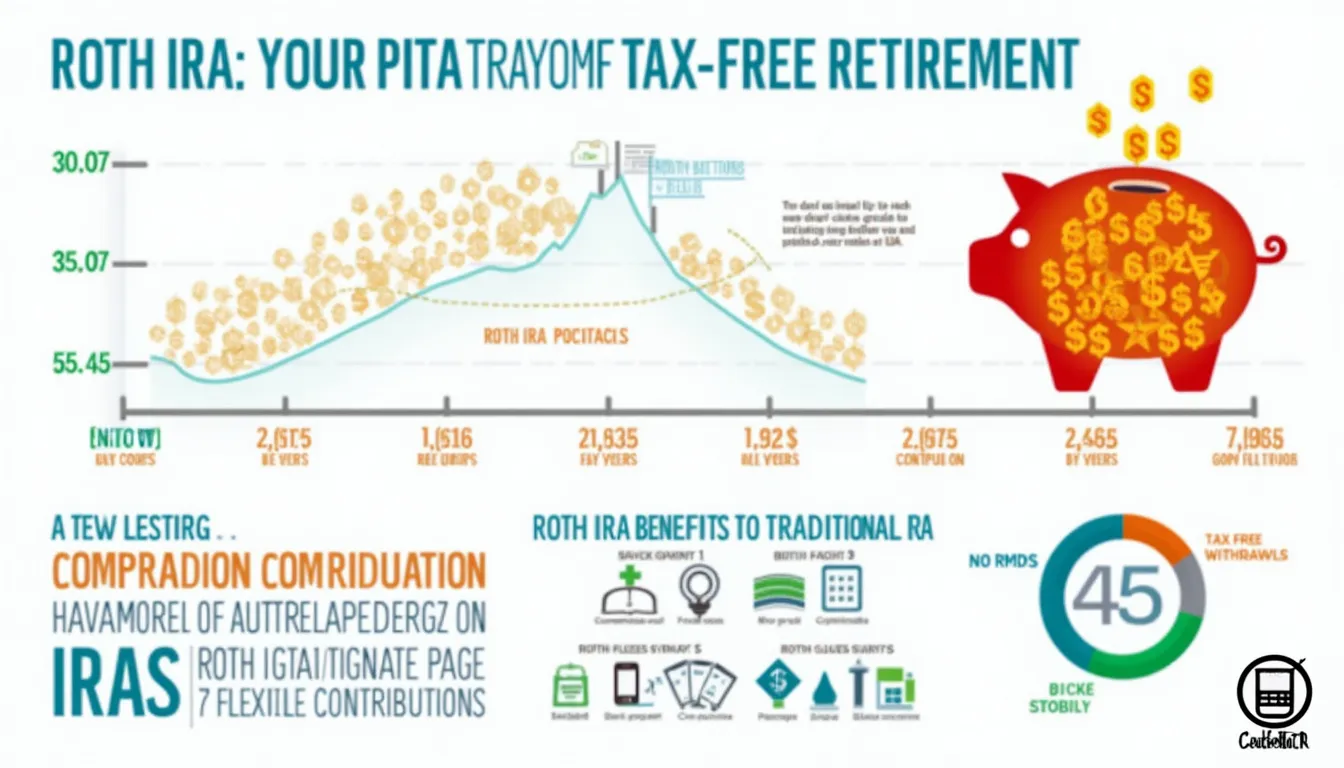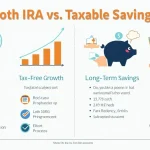Roth IRA Calculator
Is this tool helpful?
How to use the tool
- Initial Investment – enter what’s already in your Roth IRA. Example 1: $10,000. Example 2: $2,500.
- Regular Contribution – the amount you add each period. Example 1: $600 monthly. Example 2: $200 quarterly.
- Contribution Frequency – choose Monthly, Quarterly, or Annually to match your saving rhythm.
- Expected Annual Return % – realistic stock-heavy portfolios average 6-8 % (Vanguard, 2023).
- Investment Duration (Years) – years until retirement. Example 1: 25 years. Example 2: 32 years.
- Current & Retirement Age – or leave Retirement Age blank and the tool uses the duration.
- Tax Filing Status & MAGI – checks Roth contribution eligibility against IRS limits.
- Expected Inflation % – adjusts future value to today’s dollars; long-run U.S. average ≈ 2.5 % (BLS CPI, 2023).
Formula used
The calculator applies compound interest for an initial lump sum and an ordinary annuity of equal contributions:
$$ FV = PV(1+r)^n + PMT\left[ rac{(1+r)^n – 1}{r}\right] $$- PV – initial investment
- PMT – contribution per period
- r – periodic interest rate (annual rate ÷ periods/year)
- n – total periods (years × periods/year)
Worked example
- PV = $10,000, PMT = $600, r = 0.06/12 = 0.005, n = 25 × 12 = 300
- $$(1+r)^n \approx 4.466$$
- Future value of PV: $10,000 × 4.466 ≈ $44,660
- Future value of contributions: $$600 \times rac{4.466-1}{0.005} ≈ \$415,920$$
- Total future value: ≈ $460,580
- Total contributions: $10,000 + $600 × 300 = $190,000
- Total earnings: ≈ $270,580
Quick-Facts
- 2024 contribution limit: $6,500, or $7,500 if 50+ (IRS Notice 2023-75).
- Income phase-out for singles: $138,000-$153,000 MAGI (IRS Pub. 590-A, 2023).
- Early withdrawals gain a 10 % penalty before age 59½ (IRS Pub. 590-B, 2023).
- No required minimum distributions for the original owner (IRS Pub. 590-B, 2023).
- S&P 500 real return averaged 7 % since 1950 (Damodaran data, NYU, 2023).
FAQ
What is a Roth IRA?
A Roth IRA is an after-tax individual retirement account; qualified withdrawals are tax-free and have no lifetime RMDs (IRS Pub. 590-B, 2023).
How does the calculator project growth?
It compounds each contribution at your stated return rate, then adds the grown initial balance, giving an end value in today’s or nominal dollars.
Can I adjust for inflation?
Yes. Enter an inflation rate and the tool divides the nominal future value by $(1+text{inflation})^{text{years}}$ to show real purchasing power.
What if my MAGI exceeds the limit?
The eligibility checker warns you. You can still fund a Backdoor Roth via a nondeductible traditional IRA conversion (Kitces, 2024).
Why use monthly contributions?
More frequent contributions boost compounding; twelve $600 deposits earn more than one annual $7,200 deposit at the same rate.
Is the 6 % return realistic?
Morningstar’s 2024 forecast shows a 5.8 % median annual U.S. equity return; balanced portfolios trend lower (Morningstar, 2024).
Can I withdraw contributions anytime?
You may withdraw your original contributions tax- and penalty-free at any age because they were made with after-tax dollars (IRS Pub. 590-B, 2023).
How accurate are projections?
They assume constant returns and reinvestment. “Actual results vary with market volatility,” cautions the SEC Office of Investor Education (SEC, 2023).
Important Disclaimer
The calculations, results, and content provided by our tools are not guaranteed to be accurate, complete, or reliable. Users are responsible for verifying and interpreting the results. Our content and tools may contain errors, biases, or inconsistencies. Do not enter personal data, sensitive information, or personally identifiable information in our web forms or tools. Such data entry violates our terms of service and may result in unauthorized disclosure to third parties. We reserve the right to save inputs and outputs from our tools for the purposes of error debugging, bias identification, and performance improvement. External companies providing AI models used in our tools may also save and process data in accordance with their own policies. By using our tools, you consent to this data collection and processing. We reserve the right to limit the usage of our tools based on current usability factors.







